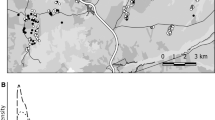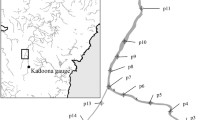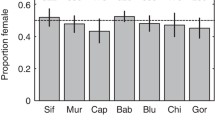Abstract
Postrelease monitoring is an important aspect of reintroduction projects, one outcome of which is to allow an assessment of the initial success of the reintroduction, often measured by quantifying survival and reproduction rates. In long-lived species, accurate estimations of demographic parameters are difficult to obtain, and therefore assessment of reintroduction success in such species is challenging. To assess the initial success of a reintroduction program for the long-lived, slow-reproducing, and critically endangered western lowland gorilla Gorilla gorilla gorilla, we analyzed postrelease monitoring data from 2 reintroduced populations, in the Batéké Plateau region of the Republics of Congo and Gabon, to quantify several demographic parameters, and compared our results with published data on wild gorilla populations. Annual survival rate of the 51 released gorillas was 97.4%, 9 females gave birth to 11 infants at an annual birth rate of 0.196 births per adult female, and first-year survival of the infants was 81.8%. Annual birth rate within the reintroduced populations is not significantly different from that given for wild western gorilla populations, and other demographic parameters fall within the range of published data for wild gorilla populations. Our analysis illustrates that the reintroduction program has been successful in terms of the initial measures of postrelease survival and reproduction, and our quantitative data should facilitate the development of a population model that can predict the probability of population persistence and therefore provide an indication of longer-term reintroduction success.

Similar content being viewed by others
References
Armstrong, D. P., & Seddon, P. J. (2008). Directions in reintroduction biology. Trends in Ecology and Evolution, 23, 20–25.
Beck, B., Walkup, K., Rodrigues, M., Unwin, S., Travis, D., & Stoinski, T. (2007). Best practice guidelines for the re-introduction of great apes. Gland, Switzerland: SSC Primate Specialist Group of the World Conservation Union.
Bout, N. (2006). Parc National des Plateaux Batéké, Gabon: Suivi écologique des grands mammifères et de l’impact humain. Rapport final. WCS-Gabon. 102 pp. Available from http://carpe.umd.edu/resources/Documents/Batéké_Ecomonitoring_Rpt_WCS2006_FR.pdf/view
Bout, N., Born, C., & Spohr, C. (2010). Evidence that the spotted hyena is present in the rainforest-savannah mosaic of south-east Gabon. Mammalian Biology, 75, 175–179.
Bradley, B. J., Robbins, M. M., Williamson, E. A., Steklis, H. D., Steklis, N. G., Eckhardt, N., Boesch, C., & Vigilant, L. (2005). Mountain gorilla tug-of-war: silverbacks have limited control over reproduction in multimale groups. Proceedings of the National Academy of Sciences of the USA, 102, 9418–9423.
Chamberlan, C. (2007). Atelier sur la gestion des grands singes orphelins au Gabon, CENAREST, Libreville, 11 et 12 octobre 2007. Franceville, Gabon: PPG-Gabon/The Aspinall Foundation.
Combreau, O., Launay, F., & Lawrence, M. (2001). An assessment of annual mortality rates in adult-sized migrant houbara bustards (Chlamydotis [undulata] macqueenii). Animal Conservation, 4, 133–141.
Courage, A., Henderson, I., & Watkin, J. (2001). Orphan gorilla reintroduction: Lesio-Louna and Mpassa. Gorilla Journal, 22, 33–35.
Cousins, D. (2002). Natural plant foods utilized by gorillas in the former Brazzaville Orphanage and the Lesio-Louna Reserve. International Zoo News, 49, 210–218.
Downer, A. (1998). A series of preliminary surveys: Ecological, demographic and socio-economic, and their implications as regards the sustainability of the Lefini Game Reserve, Republic of Congo. Masters dissertation, University of Edinburgh, UK.
Dowsett-Lemaire, F. (2001). Congo. In L. D. C. Fishpool & M. I. Evans (Eds.), Important bird areas in Africa and associated islands (pp. 191–198). Cambridge, UK: Pisces & BirdLife International.
Farmer, K. H., & Courage, A. (2008). Sanctuaries and reintroduction: A role in gorilla conservation? In T. S. Stoinski, H. D. Steklis, & P. Mehlman (Eds.), Conservation in the 21st century: Gorillas as a case study (pp. 79–106). New York: Springer.
Fischer, J., & Lindenmayer, D. B. (2000). An assessment of the published results of animal relocations. Biological Conservation, 96, 1–11.
Gaillard, J. M., Festa-Bianchet, M., & Yoccoz, N. G. (1998). Population dynamics of large herbivores: variable recruitment with constant adult survival. Trends in Ecology and Evolution, 13, 58–63.
Gerald, C. N. (1995). Demography of the Virunga mountain gorilla. Princeton, NJ: Department of Ecology and Evolutionary Biology, Princeton University.
Goossens, B., Setchell, J. M., Tchidongo, E., Dilambaka, E., Vidal, C., Ancrenaz, A., & Jamart, A. (2005). Survival, interactions with conspecifics and reproduction in 37 chimpanzees released into the wild. Biological Conservation, 123, 461–475.
Griffith, B., Scott, J. M., Carpenter, J. W., & Reed, C. (1989). Translocation as a species conservation tool: status and strategy. Science, 245, 477–480.
Harcourt, A. H. (1995). Population viability estimates: theory and practice for a wild gorilla population. Conservation Biology, 9, 134–142.
Harcourt, A. H., & Stewart, K. J. (2007). Gorilla society: Conflict, compromise, and cooperation between the sexes. Chicago: University of Chicago Press.
Hardman, B., & Moro, D. (2006). Optimising reintroduction success by delayed dispersal: is the release protocol important for hare-wallabies? Biological Conservation, 128, 403–411.
Hayman, D. T. S., King, T., & Cameron, K. (2010). Successful treatment of acute systemic anaphylaxis in a western lowland gorilla (Gorilla gorilla gorilla). Journal of Zoo and Wildlife Medicine, 41, 522–525.
Inkamba Nkulu, C., & Diahouakou, R. (2005). Sondage ecologique des mammifères dans la mosaïque forêt-savanne des Plateaux Batéké dans les Districts de Lékana, Zanaga et Bambanma. Brazzaville, Congo: Wildlife Conservation Society.
IUCN. (2002). IUCN guidelines for nonhuman primate re-introductions. Gland, Switzerland: IUCN/SSC Re-introduction Specialist Group.
IUCN. (2010). 2010 IUCN red list of threatened species. Gland, Switzerland and Cambridge, UK: The International Union for Conservation of Nature (IUCN), Species Survival Commission (SSC). Website: http://www.redlist.org.
King, T. (2004). Reintroduced western gorillas reproduce for the first time. Oryx, 38, 251–252.
King, T. (2008). Detectability and conservation of De Brazza’s monkey (Cercopithecus neglectus) in the Lesio-Louna and south-west Lefini Reserves, Batéké Plateau, Republic of Congo. Primate Conservation, 23, 39–44.
King, T. (2011). The birds of the Lesio-Louna and Lefini Reserves, Batéké Plateau, Republic of Congo. Malimbus, 33, 1–41.
King, T., & Chamberlan, C. (2007). Orphan gorilla management and reintroduction: progress and perspectives. Gorilla Journal, 34, 21–25.
King, T., & Chamberlan, C. (2008). Introduction of three sub-adult female western gorillas to a reintroduced silverback. Gorilla Gazette, 21, 37–40.
King, T., & Courage, A. (2007). Reintroduced western gorillas reproduce again. Oryx, 41, 14.
King, T., & Courage, A. (2008). Western gorilla re-introduction to the Batéké Plateau region of Congo and Gabon. In P. S. Soorae (Ed.), Global re-introduction perspectives: Re-introduction case-studies from around the globe (pp. 217–220). Abu Dhabi, UAE: IUCN/SSC Re-introduction Specialist Group. Available from: http://www.iucnsscrsg.org/.
King, T., & Dallimer, M. (2010). The fruit bats (Chiroptera: Pteropodidae) of the Lesio-Louna Reserve, Batéké Plateau, Republic of Congo. Mammalia, 74, 63–69.
King, T., Boyen, E., & Muilerman, S. (2003). Variation in reliability of measuring behaviours of reintroduced orphan gorillas. International Zoo News, 50, 288–297.
King, T., Chamberlan, C., & Courage, A. (2005a). Rehabilitation of orphan gorillas and bonobos in the Congo. International Zoo News, 52, 198–209.
King, T., Chamberlan, C., & Courage, A. (2005b). Reintroduced gorillas: reproduction, ranging and unresolved issues. Gorilla Journal, 30, 30–32.
King, T., Chamberlan, C., & Courage, A. (2006). Gorilla reintroduction, Republic of Congo. A report for the PASA/IUCN African Primate Reintroduction Workshop, 20–22 April 2006, Apeldoorn, Netherlands. Available from http://carpe.umd.edu/resources/Documents/Congo_2006_Gorilla_reintro_Lesio-Louna-LefiniReserves.pdf/view.
King, T., Chamberlan, C., Pearson, L., & Courage, A. (2009). Gorilla sanctuaries and conservation in Congo and Gabon. International Zoo News, 56, 342–352.
Maran, T., Põdra, M., Põlma, M., & Macdonald, D. W. (2009). The survival of captive-born animals in restoration programmes – Case study of the endangered European mink Mustela lutreola. Biological Conservation, 142, 1685–1692.
NASA-UMD/CARPE. (2004). CBFP Leconi – Bateke – Lefini Landscape: Landsat Image Mosaic. NASA/University of Maryland.
Nicoll, M. A. C., Jones, C. G., & Norris, K. (2003). Declining survival rates in a reintroduced population of the Mauritius kestrel: evidence for non-linear density dependence and environmental stochasticity. Journal of Animal Ecology, 72, 917–926.
Parker, K. A. (2008). Translocations: providing outcomes for wildlife, resource managers, scientists, and the human community. Restoration Ecology, 16, 204–209.
Pearson, L., & King, T. (2008). Reproduction in a second population of reintroduced western gorillas. Oryx, 42, 14.
Pearson, L., Aczel, P., Mahé, S., Courage, A., & King, T. (2007). Gorilla reintroduction to the Batéké Plateau National Park, Gabon: An analysis of the preparations and initial results with reference to the IUCN guidelines for the re-introduction of Great Apes. Franceville, Gabon: PPG-Gabon/The Aspinall Foundation. Available from http://carpe.umd.edu/resources/Documents/Gabon_2007_gorilla_reintro_BatékéPlateauNP.pdf/view.
Pearson, L., Aczel, P., Mahé, S., Courage, A., & King, T. (2008). Gorilla reintroduction in Gabon. Gorilla Gazette, 21, 41–44.
Richard-Hansen, C., Vie, J., & de Thoisy, B. (2000). Translocation of red howler monkeys (Alouatta seniculus) in French Guiana. Biological Conservation, 93, 247–253.
Robbins, M. M., & Robbins, A. M. (2004). Simulation of the population dynamics and social structure of the Virunga mountain gorillas. American Journal of Primatology, 63, 201–223.
Robbins, M. M., Bermejo, M., Cipolletta, C., Magliocca, F., Parnell, R. J., & Stokes, E. (2004). Social structure and life-history patterns in western gorillas (Gorilla gorilla gorilla). American Journal of Primatology, 64, 145–159.
Robbins, M. M., Gray, M., Kagoda, E., & Robbins, A. M. (2009). Population dynamics of the Bwindi mountain gorillas. Biological Conservation, 142, 2886–2895.
Santos, T., Pérez-Tris, J., Carbonell, R., Tellería, J. L., & Díaz, J. A. (2009). Monitoring the performance of wild-born and introduced lizards in a fragmented landscape: implications for ex situ conservation programmes. Biological Conservation, 142, 2923–2930.
Sarrazin, F., & Barbault, R. (1996). Reintroduction: challenges and lessons for basic ecology. Trends in Ecology and Evolution, 11, 474–478.
Seddon, P. J. (1999). Persistence without intervention: assessing success in wildlife reintroductions. Trends in Ecology and Evolution, 14, 503.
Seddon, P. J., Armstrong, D. P., & Maloney, R. F. (2007). Developing the science of reintroduction biology. Conservation Biology, 21, 303–312.
Stokes, E. J., Parnell, R. J., & Olejniczak, C. (2003). Female dispersal and reproductive success in wild western lowland gorillas (Gorilla gorilla gorilla). Behavioral Ecology and Sociobiology, 54, 329–339.
Strum, S. C. (2005). Measuring success in primate translocation: a baboon case study. American Journal of Primatology, 65, 117–140.
Trent, T. T., & Rongstad, O. J. (1974). Home range and survival of cottontail rabbits in south-western Wisconsin. Journal of Wildlife Management, 38, 459–472.
Tutin, C. E. G., Ancrenaz, M., Paredes, J., Vacher-Vallas, M., Vidal, C., Goossens, B., Bruford, M. W., & Jamart, A. (2001). The conservation biology framework of the release of wild-born orphaned chimpanzees into the Conkouati Reserve, Congo. Conservation Biology, 15, 1247–1257.
van Heezik, Y., Seddon, P. J., & Maloney, R. F. (1999). Helping reintroduced houbara bustards avoid predation: effective anti-predator training and the predictive value of pre-release behaviour. Animal Conservation, 2, 155–163.
Wakamiya, S. M., & Roy, C. L. (2009). Use of monitoring data and population viability analysis to inform reintroduction decisions: peregrine falcons in the Midwestern United States. Biological Conservation, 142, 1767–1776.
Walters, G., Bradley, A., & Niangadouma, R. (2006). Floristics of Gabon’s Batéké Plateaux: Guineo-Congolian plants on Kalahari Sands. In S. A. Ghazanfar & H. J. Beentje (Eds.), Taxonomy and ecology of African plants, their conservation and sustainable use (pp. 259–266). Kew: Royal Botanic Gardens.
White, F. (1983). The vegetation of Africa. Paris: UNESCO.
Wolf, C. M., Griffith, B., Reed, C., & Temple, S. A. (1996). Avian and mammalian translocations: update and reanalysis of the 1987 survey data. Conservation Biology, 10, 1142–1154.
Yaeger, C. P. (1997). Orangutan rehabilitation in Tanjung Putting National Park, Indonesia. Conservation Biology, 11, 802–805.
Yamagiwa, J., & Kahekwa, J. (2001). Dispersal patterns, group structure, and reproductive parameters of eastern lowland gorillas at Kahuzi in the absence of infanticide. In M. M. Robbins, P. Sicotte, & K. Stewart (Eds.), Mountain gorillas: Three decades of research at Karisoke (pp. 89–122). Cambridge, UK: Cambridge University Press.
Acknowledgments
We thank the Ministry of Forest Economy of the government of Congo, the Ministry of Water and Forests and the National Agency for National Parks of the government of Gabon, and The Aspinall Foundation of UK for their long-term commitment to and funding of the reintroduction and protected area management projects. We also thank the Wildlife Conservation Society (USA), Florent Ikoli, Mbani Akangala Mankarika, and Roland Missilou-Boukaka (Congolese government); and Adrien Noungou, Pierre Ngavoura, Mamadou Ntsoumou, and René Bazin Assaly (Gabonese government) for their contribution to protected area management and conservation within the Batéké Plateau; Liz Pearson, Paul Aczel, and Sandrine Mahé for significant contributions to earlier versions of this article; and Joanna Setchell and 3 anonymous reviewers for their constructive comments on the article. The information presented here results from 2 decades of dedicated work by numerous project staff, all of whom we deeply thank and without whom this program would never have been possible.
Author information
Authors and Affiliations
Corresponding author
Rights and permissions
About this article
Cite this article
King, T., Chamberlan, C. & Courage, A. Assessing Initial Reintroduction Success in Long-Lived Primates by Quantifying Survival, Reproduction, and Dispersal Parameters: Western Lowland Gorillas (Gorilla gorilla gorilla) in Congo and Gabon. Int J Primatol 33, 134–149 (2012). https://doi.org/10.1007/s10764-011-9563-2
Received:
Accepted:
Published:
Issue Date:
DOI: https://doi.org/10.1007/s10764-011-9563-2




